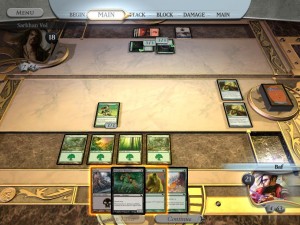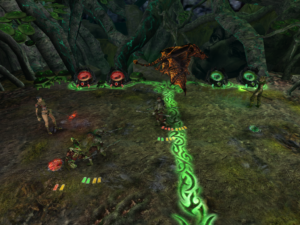So, I’m continuing to let that “Treasure Hunt” promotion on Steam dictate what I do with my spare time. The latest round featured two games that I already had. First up is Magic: The Gathering – Duels of the Planeswalkers, the newest and slickest adaptation of the card game. I purchased this a while back when it was on sale for about the price of a booster pack. And now that I’ve spent a little quality time with it, I’ve already completed its single-player campaign, as well as all of its “challenges”. I rather like the challenges. They’re essentially Magic: The Gathering problems, in the same sense as chess problems. You’re shown a situation from late in a game, and have one turn to win, which you can only do by exploiting some unintuitive combo. In other words, it’s the best part of the original game, isolated.
 DotPW is a pretty straightforward adaptation: it’s presented as a card game, and makes no pretense at being anything else, apart from some sound and graphical effects on casting spells or resolving combat. But it’s a card game played on an attractive table, with a nicely responsive UI. There are some interesting things going on with tooltips that expand to give more information if you hover over a card longer. Your hand is displayed as a row of overlapping cards, with mouse rollover bringing specific cards to the front and enlarging them slightly; move the mouse away, and the card reduces to its original size, but stays in front. Spells you can currently cast are highlighted with a sort of glowing aura around their edges. You can zoom into and out of a full-screen-height view of a card with a flick of the mouse scrollwheel, which feels a lot better than it sounds. Still, I have complaints. There are a couple of buttons at the bottom of the screen that overlap with your hand, and when you roll over them, you get the card rollover effect as well, which falsely implies that clicking there will activate the card. The menu at the top of the screen, which you use for things like changing options or quitting the game, always confuses me. The button labeled “menu” toggles it between showing the menu and showing a display of the current phase, with the phase display appearing as a beveled layer on top of the menu, which is painted directly on the surface of the window border. In other games and apps where you have to explicitly summon a menu bar, it appears as an overlay on top of the window, not as the thing remaining when an overlay goes away. So every time I summon the main menu, I’m briefly confused into thinking I’ve accidentally banished it instead, and sometimes click the button again to bring it back, which sends it away for real.
DotPW is a pretty straightforward adaptation: it’s presented as a card game, and makes no pretense at being anything else, apart from some sound and graphical effects on casting spells or resolving combat. But it’s a card game played on an attractive table, with a nicely responsive UI. There are some interesting things going on with tooltips that expand to give more information if you hover over a card longer. Your hand is displayed as a row of overlapping cards, with mouse rollover bringing specific cards to the front and enlarging them slightly; move the mouse away, and the card reduces to its original size, but stays in front. Spells you can currently cast are highlighted with a sort of glowing aura around their edges. You can zoom into and out of a full-screen-height view of a card with a flick of the mouse scrollwheel, which feels a lot better than it sounds. Still, I have complaints. There are a couple of buttons at the bottom of the screen that overlap with your hand, and when you roll over them, you get the card rollover effect as well, which falsely implies that clicking there will activate the card. The menu at the top of the screen, which you use for things like changing options or quitting the game, always confuses me. The button labeled “menu” toggles it between showing the menu and showing a display of the current phase, with the phase display appearing as a beveled layer on top of the menu, which is painted directly on the surface of the window border. In other games and apps where you have to explicitly summon a menu bar, it appears as an overlay on top of the window, not as the thing remaining when an overlay goes away. So every time I summon the main menu, I’m briefly confused into thinking I’ve accidentally banished it instead, and sometimes click the button again to bring it back, which sends it away for real.
As someone who used to play M:tG but doesn’t follow it any more, it’s always interesting to see how the cards have developed since the last time I paid attention (which is to say, the last time a M:tG computer game game out). I’m noticing that some things that used to be special properties of specific cards are now attributes covered in the general rules, and represented by icons in the UI here. For example, giant spiders have always had the ability to block flying creatures despite not being flying creatures themselves, but nowadays, it seems, it’s because they have the “Reach” attribute, which I assume is shared by some other cards. At the same time, of course, a new set of exceptions move in to take their place. I noticed that there are multiple Flying creatures here that, unlike most fliers (but like all flying creatures in Magic: The Gathering – Battlegrounds), can’t block non-flying creatures. I suppose this means that this could become an Attribute in future editions — call it “terraphobic” or something. Or perhaps not: the main advantage of Attributes over Exceptions seems to be that they can be granted as effects from enchantments and the like, and binding an effect like that to any arbitrary creature might not make good gameplay.
The one really curious choice here is that the game doesn’t let you make your own deck. Instead, you unlock various pre-made decks, then unlock additional cards for use in those decks. This cuts out about three-quarters of the M:tG experience. Furthermore, I’m told by someone who’s a lot more into M:tG than I’ve ever been that the decks available here are substandard. Which, I suppose, is why they don’t let you mix them up: there’s a good chance you’d come up with something better. Me, I’m far enough out of the loop to be satisfied with what I’ve been given, to take the more Etherlords-like constraints as part of this game, as opposed to real M:tG. But that raises the interesting question of just who this game is for.
There are games that you play once and they’re over: adventure games and puzzle games are the firmest examples. Like books and movies, they can enter the cultural vocabularies of the people who have played them, but they’re things that their fans have played, not things that they play. When they’re not freeware, the business model behind games like this is to keep selling you new games. Then there are lifestyle games: things like World of Warcraft and Team Fortress 2, things where the fan community consists of people who play them routinely. One of the hallmarks of this sort of game is focus on multiplayer play, which keeps people invested with minimal effort on the developers’ part. The business model here varies — WoW has monthly fees, TF2 seems to have been basically a loss leader for Steam until they discovered the lucrative hat market, and then there are ad-supported and DLC-supported games. DotP clearly wants to be a lifestyle game supported by DLC. It pushes players toward multiplayer play with its very short single-player campaign, and it has multiple expansions containing new decks (not to mention frippery like the “foil unlocks”, which let you pay a dollar just to make your cards shinier.) But you’d think that the people who’d want to keep paying for extra content would be the die-hard M:tG enthusiasts, whereas this game is set up, at a foundational level, to cater to the newbies. The fixed decks put a limit on the extent to which knowledge and experience of the game can affect the outcome: no one can build a deck significantly better than yours, and luck of the draw plays an even larger role than in normal M:tG. It solves the basic problem with face-to-face M:tG, the problem of how the newcomer can hope to compete with the guy who spends hundreds of dollars getting just the cards he wants in his deck. On the other hand, it seems like this wouldn’t be considered a problem by the guy who spent the hundreds of dollars, or by the vendor he paid them to.
But who am I to talk? Apparently DotP has sold really well. Maybe Wizards of the Coast has the right idea here: the number of dedicated M:tG fans has surely dwindled over time, whereas people like me, who have a slight interest in the game but not enough to actually buy cards or find other players, are surely legion. DotP is a game designed for us, the tourists in the Magic world. It takes us by the hand and shows us the sights, and lets us indulge in a fantasy of playing a game, with all the complicated and unpleasant parts removed. We may not be all that dedicated to the game, but judging by the Steam Global Achievement list, a little over a third of us went as far as to buy the first expansion.
I probably won’t go that far myself. I think I’ve learned what I wanted to learn from this game. But I can imagine it happening after a while, particularly if I can get the online component working. M:tG is moreish: you always want to keep playing until that one ultra-powerful card or combo comes up, and once it does, the match is over before you can really savor it. So I might keep bringing this game out, and if I do, I can imagine getting bored with the decks it provides and wanting a fresh batch. If it happens, I’ll report it here.
 Comments(2)
Comments(2)
